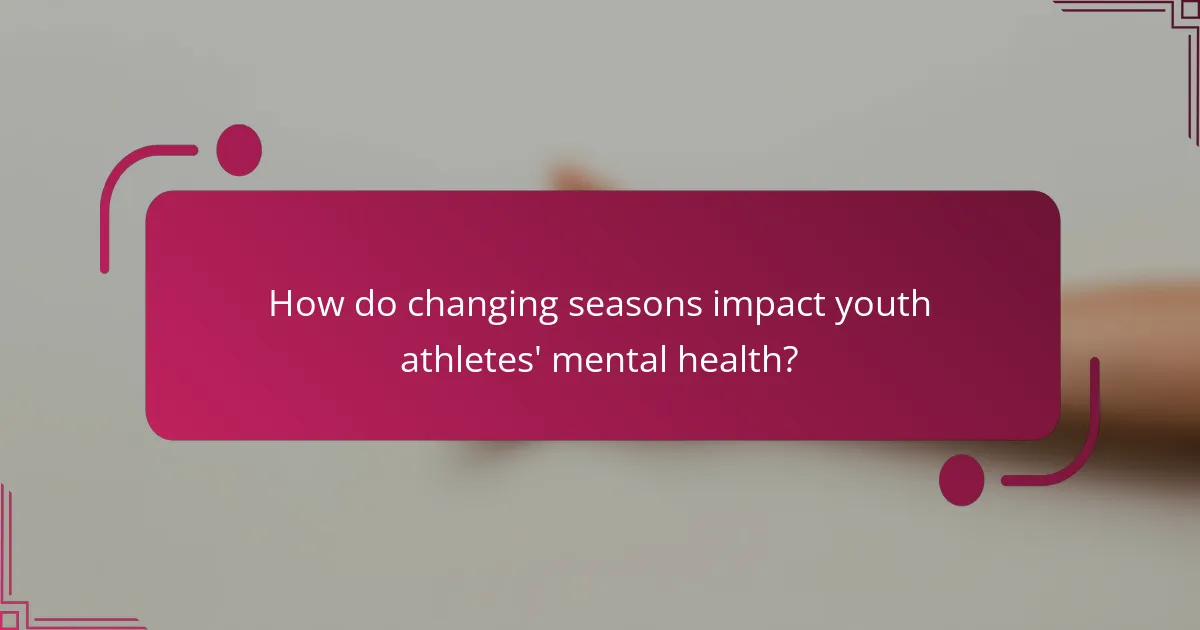Changing seasons can profoundly affect youth athletes’ mental health and performance. Fluctuations in mood and motivation often arise due to changes in daylight and weather conditions. Seasonal Affective Disorder (SAD) may lead to feelings of depression in winter, while spring and summer typically enhance energy levels. Additionally, transitions between seasons can create anxiety related to training and competition schedules, impacting overall mental resilience.

How do changing seasons impact youth athletes’ mental health?
Changing seasons significantly impact youth athletes’ mental health and performance. Seasonal changes can lead to fluctuations in mood, motivation, and overall mental well-being.
During winter, reduced daylight can contribute to Seasonal Affective Disorder (SAD), causing feelings of depression and lethargy. Conversely, spring and summer often boost energy levels and enthusiasm due to increased sunlight and outdoor activity opportunities.
Research indicates that athletes may experience heightened anxiety during transitions between seasons, particularly when adjusting to new training regimens or competition schedules. This can affect their performance and mental resilience.
Maintaining a consistent routine and incorporating outdoor activities can help mitigate negative effects. Engaging in team sports during favourable weather can enhance social connections, promoting better mental health among young athletes.
What are the common mental health challenges faced by youth athletes during seasonal transitions?
Youth athletes commonly face anxiety, depression, and performance pressure during seasonal transitions. These challenges arise due to changes in training intensity, competition schedules, and social dynamics.
Anxiety can increase as athletes adjust to new team dynamics and expectations. Depression may stem from the pressure to perform consistently across seasons. Additionally, fluctuations in weather can impact mood and energy levels, influencing overall mental well-being.
Performance pressure often intensifies during transitions, as athletes strive to meet new goals. This pressure can lead to burnout if not managed effectively. Understanding these challenges is crucial for supporting youth athletes’ mental health throughout the year.
How do seasonal changes affect performance in youth sports?
Seasonal changes significantly impact youth athletes’ mental health and performance. Factors such as weather, daylight, and temperature influence motivation and energy levels.
In colder months, reduced daylight can lead to lower mood and decreased physical activity. Conversely, warmer months often encourage outdoor play, enhancing physical performance and social interaction.
Research shows that seasonal affective disorder (SAD) can affect young athletes, leading to decreased performance during winter. Increased exposure to sunlight in spring and summer can improve mood and athletic output.
Coaches and parents should consider these seasonal effects to support youth athletes effectively. Implementing strategies like flexible training schedules can help maintain performance throughout the year.
What specific performance metrics are influenced by seasonal changes?
Seasonal changes significantly influence performance metrics in youth athletes, including endurance, strength, and motivation levels. For instance, winter may lead to decreased outdoor activity, impacting cardiovascular fitness. In contrast, spring often enhances mood and energy, potentially improving overall performance. Additionally, fluctuations in temperature and daylight can affect training schedules and recovery rates. These variations necessitate adaptive training strategies to maintain optimal performance year-round.

What universal factors contribute to mental health fluctuations in youth athletes?
Changing seasons significantly impact youth athletes’ mental health and performance due to environmental and psychological factors. Seasonal changes affect mood, motivation, and training conditions, leading to fluctuations in mental health.
The transition from summer to autumn can bring about decreased sunlight exposure, which may lead to seasonal affective disorder (SAD) in some athletes. This condition can result in feelings of sadness and lethargy, negatively influencing performance.
Winter months often present challenges such as limited outdoor training opportunities, which can lead to feelings of isolation. Conversely, spring and summer typically encourage outdoor activities, enhancing social interactions and overall mental well-being.
Additionally, the pressure to perform during specific seasons can create stress, impacting mental health. Athletes may experience anxiety related to competition schedules, which can fluctuate with the seasons. Recognising these factors is crucial for supporting youth athletes’ mental health throughout the year.
How does weather variation influence mood and motivation?
Weather variation significantly influences mood and motivation in youth athletes. Seasonal changes can affect mental health and performance, with studies showing that sunlight exposure boosts serotonin levels, enhancing mood. Conversely, gloomy weather can lead to decreased motivation and increased feelings of fatigue.
Research indicates that athletes may experience lower energy levels during winter months, impacting their training consistency. Seasonal Affective Disorder (SAD) can also be a concern, particularly among those sensitive to light changes. Encouraging outdoor activities during sunny days can help mitigate these effects, promoting better mental health and performance.
In summary, understanding the impact of weather on youth athletes can help coaches and parents create supportive environments that foster motivation and mental well-being throughout the year.
What role does social support play during seasonal changes?
Social support significantly enhances youth athletes’ mental health and performance during seasonal changes. It provides emotional stability, reduces stress, and fosters resilience. Studies show that strong social networks can mitigate the negative effects of seasonal affective disorder, which may impact motivation and focus. Additionally, supportive relationships encourage athletes to engage in healthy coping strategies, promoting overall well-being.

What unique seasonal challenges do youth athletes face?
Youth athletes face unique seasonal challenges that impact their mental health and performance. Weather changes can lead to fluctuations in motivation and energy levels.
The transition from warm to cold seasons often affects outdoor training schedules, limiting practice opportunities. This can result in decreased physical conditioning, which may heighten anxiety during competitions.
Additionally, seasonal affective disorder (SAD) can emerge in youth athletes during winter months, leading to mood swings and reduced focus. As a result, coaches and parents should monitor mental well-being closely.
Finally, the shift in daylight hours can disrupt sleep patterns, further complicating an athlete’s performance. Establishing consistent routines can help mitigate these effects.
How does seasonal affective disorder manifest in young athletes?
Seasonal affective disorder (SAD) in young athletes manifests through increased fatigue, mood swings, and decreased motivation. These symptoms can lead to lower performance levels and reduced participation in training. Studies indicate that approximately 10% of youth athletes experience SAD during winter months, impacting their mental resilience and overall well-being. As a result, mental health support and light therapy may be essential for maintaining performance and emotional stability.
What are the implications of off-season transitions on mental health?
Off-season transitions can significantly impact youth athletes’ mental health. Changes in routine and environment may lead to feelings of isolation and anxiety.
During off-seasons, athletes often experience a decrease in social interaction, which can affect their emotional well-being. This isolation may contribute to increased stress levels and decreased motivation.
Moreover, fluctuating performance expectations can exacerbate mental health challenges. Athletes may struggle with self-esteem and identity, which are closely tied to their sports performance.
Implementing structured off-season programmes can mitigate these effects. Engaging in team-building activities and mental health resources can support athletes’ emotional resilience during transitions.

What rare but notable effects do seasons have on youth athletes’ mental well-being?
Changing seasons can significantly impact youth athletes’ mental well-being, leading to both positive and negative effects. Seasonal changes may influence mood, motivation, and overall mental health due to variations in weather and daylight.
One rare effect is seasonal affective disorder (SAD), which can lead to depressive symptoms during winter months when sunlight is limited. This condition may hinder an athlete’s performance and motivation. Conversely, spring and summer often bring increased energy and enthusiasm, enhancing athletic performance and mental resilience.
Research indicates that the transition between seasons can also affect sleep patterns, which are crucial for recovery and mental clarity. Youth athletes may experience disrupted sleep in winter, impacting their performance.
In contrast, the longer days of summer provide more opportunities for outdoor training and social interaction, which can boost morale and mental health. Understanding these seasonal effects can help coaches and parents support youth athletes more effectively.
How can changes in daylight impact training and mental focus?
Changes in daylight significantly impact training and mental focus for youth athletes. Longer daylight hours can enhance motivation and energy levels, leading to improved performance. Seasonal variations in light exposure influence mood and concentration, with increased sunlight correlating to better mental health outcomes. Studies show that athletes training during brighter months report higher levels of focus and reduced fatigue.
What are the psychological effects of seasonal injuries in youth sports?
Seasonal injuries in youth sports can significantly impact mental health and performance. These injuries often lead to feelings of frustration, anxiety, and isolation among young athletes. Research indicates that prolonged recovery periods can exacerbate these psychological effects, leading to decreased motivation and self-esteem.
The transition between seasons may also disrupt training routines, further affecting mental preparedness. Youth athletes may struggle with identity issues when sidelined, as sports often play a crucial role in their social lives. Addressing these psychological challenges is essential for promoting resilience and ensuring a smoother return to sport.
Engaging in supportive team environments and mental health resources can help mitigate these effects. Encouraging open communication about feelings and providing coping strategies are vital for youth athletes facing seasonal injuries.

How can coaches and parents support youth athletes through seasonal changes?
Coaches and parents can support youth athletes through seasonal changes by fostering open communication, providing mental health resources, and adjusting training schedules. Seasonal changes can impact mental health and performance due to variations in weather, daylight, and motivation levels.
Encouraging athletes to express their feelings about seasonal challenges can enhance their emotional resilience. Providing access to mental health professionals can help address anxiety or stress related to performance. Adjusting training regimens to account for seasonal conditions, such as heat in summer or cold in winter, ensures athletes remain safe and engaged.
Additionally, promoting team-building activities during off-seasons can maintain camaraderie and motivation. Recognising the unique challenges each season presents enables coaches and parents to create supportive environments that nurture athletes’ mental well-being and performance.
What strategies can be implemented to enhance resilience in youth athletes?
To enhance resilience in youth athletes, implement strategies that focus on mental conditioning, social support, and adaptive coping skills. These strategies include fostering a growth mindset, encouraging open communication, and setting achievable goals.
1. Promote a growth mindset by teaching athletes to view challenges as opportunities for improvement.
2. Establish a strong support network involving coaches, parents, and peers to provide encouragement and guidance.
3. Incorporate mental training techniques such as visualization and mindfulness to help athletes manage stress and anxiety.
4. Encourage goal-setting that emphasizes process over outcome to build confidence and perseverance.
5. Facilitate team-building activities to strengthen relationships and foster a sense of belonging.
6. Provide education on healthy coping mechanisms to handle setbacks and pressure effectively.
How can communication improve mental health outcomes during seasonal transitions?
Effective communication can significantly enhance mental health outcomes for youth athletes during seasonal transitions. Open dialogue about feelings and experiences fosters resilience and coping strategies.
Research shows that athletes who discuss their mental health challenges with coaches or peers report better emotional regulation. Seasonal changes can trigger mood fluctuations; thus, timely communication can mitigate these effects.
Encouraging athletes to express their concerns can lead to tailored support, improving their overall performance. As a result, proactive communication strategies are essential for promoting mental well-being in youth sports during these transitions.
What are the best practices for monitoring mental health in youth sports?
To effectively monitor mental health in youth sports, coaches and parents should prioritise open communication and establish supportive environments. Regular check-ins can identify emotional changes, while training sessions should incorporate mental health discussions.
Additionally, implementing structured feedback mechanisms allows athletes to express their feelings about performance and stress. Creating awareness about seasonal changes, such as increased pressure during competitions, can help in recognising potential mental health impacts.
Encouraging peer support fosters resilience and belonging, which is essential for youth athletes. Lastly, collaborating with mental health professionals can provide valuable resources and guidance tailored to the unique challenges faced by young athletes.
What common mistakes should be avoided when addressing mental health in youth athletes?
Youth athletes should avoid common mistakes that can negatively impact their mental health, particularly during seasonal changes. One mistake is neglecting communication about feelings, which can lead to isolation. Another is overemphasising performance, causing stress and anxiety. Additionally, disregarding the importance of rest can hinder recovery and mental well-being. Lastly, failing to recognise signs of mental fatigue can exacerbate issues, affecting both performance and personal health.
How can youth athletes advocate for their mental health needs during seasonal changes?
Youth athletes can effectively advocate for their mental health needs during seasonal changes by communicating openly with coaches and parents. They should express feelings of stress or anxiety related to performance fluctuations caused by changing weather and daylight.
Establishing a routine that incorporates mental health practices, such as mindfulness or relaxation techniques, can also help manage seasonal transitions. Engaging in peer support groups or mental health workshops provides additional resources for coping strategies.
Regular check-ins with mental health professionals can ensure ongoing support tailored to their unique experiences. Furthermore, athletes should be encouraged to prioritise self-care, including adequate rest and nutrition, to maintain overall well-being during these times.